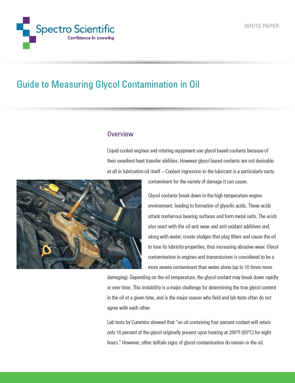 There are 5 common tests for glycol in engine oil. These include:
There are 5 common tests for glycol in engine oil. These include:
- IR Spectroscopy
- Atomic Emission Spectroscopy
- Blotter Test
- Schiffer's Reagent Method
- Gas Chromatography
Liquid cooled engines and rotating equipment use glycol based coolants because of their excellent heat transfer abilities. However, glycol based coolants are not desirable at all in lubrication oil itself – Coolant ingression to the lubricant is a particularly nasty contaminant for the variety of damage it can cause. Glycol coolants break down in the high temperature engine environment, leading to formation of glycolic acids. These acids attack nonferrous bearing surfaces and form metal salts. The acids also react with the oil anti wear and anti oxidant additives and, along with water, create sludges that plug filters and cause the oil to lose its lubricity properties, thus increasing abrasive wear. Glycol contamination in engines and transmissions is considered to be a more severe contaminant than water alone (up to 10 times more damaging). Depending on the oil temperature, the glycol coolant may break down rapidly, or over time. This instability is a major challenge for determining the true glycol content in the oil at a given time, and is the major reason why field and lab tests often do not agree with each other.
Methods for Measuring Glycol Contamination
Blotter Test
A sheet of common blotter paper is placed on a flat surface and a dipstick is used to place a few drops of oil in the middle of the sheet and left for an hour.
Schiffer's Reagent Method (Gly-Tek Kit)
Perhaps the best known quick test for glycol is the Schiff’s reagent method (ASTM D2982).
Gas Chromatography
The most commonly used GC procedure for glycol analysis is ASTM 4291, “Standard Test Method for Trace Ethylene Glycol in Used Engine Oil.”
IR Spectroscopy
Infrared Spectroscopy is commonly used in the lab or in the field to detect a series of molecular contaminants and lubricant chemistry degradation parameters. Infrared spectroscopy uses an Infrared radiation source, a sample holder, a detector, and a computer to study the interaction of matter and light.
Atomic Emission Spectroscopy
Elemental analysis by Inductively Coupled Plasma (ICP) emission spectroscopy or by arc-spark Rotating Disc Electrode (RDE) emission spectroscopy has been standard practice for oil analysis testing labs for years, as detailed in ASTM D5185 and ASTM D6595.
Glycol is a potent contaminant that must be monitored whenever it is employed for heat transfer duties in engines or rotating equipment. There are several direct and indirect methods for glycol detection in oil, and more than one may be required to understand if a problem is occurring.
To read more, click here.


